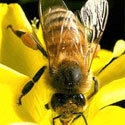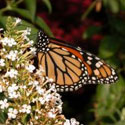Useful Colors
See how insects use color as a form of communication


Look at the above examples.
What You Will Learn
In this activity you will see how insects use color to hide and as a warning sign to show their danger.
What You Need
8 sheets of colored paper: 
- 2 blue
- 2-red
- 2-green
- 2-white
(you may use other colors)
a hole puncher
colored toothpicks
What to Do
Find eight sheets of colored paper. The sheets should not have any lines or patterns on them. Using a paper punch, punch out 20 holes from each of the colors. Mix all the dots together in a jar. These dots will become the 'insect prey'.
For the first round of searching, select one of the un-punched pieces of paper, this becomes your 'habitat'. Mix the dots and then dump them over the habitat sheet.
Now, you are the predator. With your friend timing you, pick up as many 'prey' dots as you can in 30 seconds. You may pick up only one dot at a time, and you may not pick up the habitat.
After 30 seconds, count the number of colored dots collected and record the number on the table (26KB pdf). Return all of the dots to the container and repeat the process using the other three colored habitats.
Next, go outdoors and try this activity using colored toothpicks or beans. Count out an equal number of each. Select an area about 10 feet by 10 feet. Choose a lawn, playground, asphalt, or concrete surface or any without tall bushes or plants.
Scatter the colored toothpicks or beans over the measured area. Have your friend time you for 30 second as you collect as many toothpicks or beans of different colors as you can.
Think About It
-
Q- How many beans or toothpicks did you collect?
Q- What color bean or toothpick was collected the most?
Q- Why do you think that color was most often collected?The beans and toothpicks are like insects trying to hide from a predator. The first ones that get "eaten" are the ones with bright colors that are easy to see. The beans and toothpicks that blended into their surroundings were more likely to escape their "predators". Insects such as the moth at the beginning of this lesson avoid predators by looking like part of the tree. This is called camouflage. Other insects such as the bee or butterfly use bright colors to warn enemies that they are poisonous or bad tasting. Colors such as yellow, red, or orange warn of danger in the insect world. Always be careful of handling any unknown insect with these colors.

